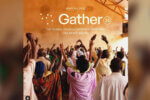In the Dominican Republic, where occult practices have been mixed with Christianity for centuries, the Holy Spirit is cleansing His church.
She attended Mass devotedly, but the roles of spiritual seeker and guide would be reversed when the priest made his secret visits to her home to consult the spirits through her. Inheriting the “gift” from her mother, Micaela saw no conflict between her prayers in church and reading of the cards and candles in front of her private altar.
But though she was widely sought after for her abilities, she wrestled with an inner emptiness that led her deeper into the arcane. Then a friend told her about a church where they talked about Jesus as a living friend, and during a visit she realized that she had found what she had been looking for.
“I had been involved in metaphysics and these other philosophies; when I came to know Jesus, everything was so clear, so easy–you didn’t have to go and do anything or pay anyone,” she recalls.
Micaela decided she had to get rid of the altar–where scented candles, oils, holy water, fruits and flowers were placed as offerings to the Virgin Mary and other saints–despite the warning from friends that if she did so the spirits she had previously turned to for help would “come against her.”
But after smashing the altar and renouncing her involvement with it, she felt the presence of God flood her home. “My life has turned around 180 degrees,” she says. “I feel free, feel peace. Before when I wanted something I would have to do lots of rituals; now I know that I have a heavenly Father, and I can just pray and ask Him.”
Micaela’s story is far from unusual, not only in the Dominican Republic (DR), but also the wider Caribbean region, where syncretism–the merging of different religious beliefs and practices–is woven through its history and culture. Just as those in other countries in Latin America that have known the intertwined legacies of Spanish rule, Catholic domination and African slavery, Dominicans readily embrace the reality of the spiritual world.
But their mixing of tribal beliefs and traditional Christianity replaces the gospel of grace and freedom with deities that need to be appeased. Beneath a veneer of Christian teaching are often pagan concepts and occult practices.
They may attend church regularly, but wear charms to ward off evil. They pray for health, but visit the curanderos (faith healers) or brujos (witches) to make them better. A prominent businessman recently tried to sue after the spell he paid to have cast failed to win him the love he was seeking. Botanicas, or herb shops, sell potions with which customers can shower to gain business favor, sexual potency, romantic interest or good luck.
Santeria, or the “way of the saints,” which essentially gave Catholic saints’ names to the spiritist deities revered by African slaves, is widespread. Espiritismo, or spiritism, is practiced by many churchgoers such as Micaela who believe those they make contact with are sent by God. Liborismo and the Brotherhood of the Holy Spirit of the Congos are two Catholic-related cults that flourish, while more recently syncretism in one of its contemporary forms–New Age–has begun to grow.
Then there is voodoo imported from neighboring Haiti, which shares the Caribbean island with its larger and more populous neighbor probably best known to Americans only for its baseball players, good beaches, cigars and easy divorce laws.
Voodoo here is more sinister than its frequent B-movie portrayal–so much so that one travel firm that offers tourists a visit to a typical ceremony, where spirit possession is welcomed, cautions that while it is a “fascinating experience” it is not for the squeamish.
Religious syncretism is simply “pervasive, but not visible,” observes Israel Brito, a pastor and missiologist who has played a key part in the growth of evangelical churches during the last dozen or so years. “Dominicans are, by background, magical people; it plays a role in everything we do, from our health to our relationships to our taboos.”
Challenging the Darkness
Although most of the Dominican Republic’s 8 million population is ostensibly Roman Catholic, there are probably only as many devout Catholics as there are evangelicals. Since around 1990 the evangelical church has doubled to about 7 percent of the population, through some aggressive evangelistic efforts.
Prayer and spiritual warfare are also, not surprisingly, an important element in the advances that have been made. Pastor and nationally known Christian broadcaster Jorge Plourde is widely recognized as a leading authority on the subjects, crediting an emphasis on them with his church having planted almost 40 new congregations during the last decade.
At the end of August he rallied hundreds of Christians in the national boxing stadium in the capital, Santo Domingo, to give the devil a thumping. The all-night prayer rally was held for the second successive year in advance of September’s festivals venerating many patron saints and culminating in a feast for the Virgin Mary.
As a worship band played and intercessors circled under the domed ceiling, Plourde stood in the ring, punching a fist into the air as he declared: “Glory to God! We are here to declare that Jesus is the Lord of the Dominican Republic!” He told Charisma in an interview: “We have to cover the spiritual realm against [the festivals] because idolatry is dominant over the Dominican Republic.”
Plourde’s call to tough prayer has been embraced by many, with pastors and intercessors going to some of the “high places” of history to call on God to break the power of the past.
But he caused even some close allies to question his methods when he set his sights on the Independence Day celebrations in the capital. The Mardi Gras-style event has traditionally been avoided by Christians for its revelry and glorification of wickedness, epitomized by the wearing of horned masks. But Plourde decided to put a float in the parade.
Members of his church spent a month in prayer and fasting beforehand, then walked the length of the carnival route a few days before the event, praying and sprinkling anointing oil. On the day, they manned a giant float decorated as a lion and handed out thousands of tracts. “We have to go into the place and rebuke the spirits,” he says. “It’s like softening the air.”
While they may not be as evident as in the Independence Day partying, spiritual clashes are almost routine in many churches, too, as people come to Christ from syncretistic involvement. Foursquare missionary Charlie Finocchario recalls how one “sweet young girl” who had been dedicated to the spirits by her mother ended up writhing on the floor like a snake when he prayed for her.
“Churches work a lot in the area of inner healing and breaking ties with the past,” he says. “There are people involved in Santeria, and they fear stopping because they fear the powers they have contacted won’t let them leave.”
Pastors routinely teach about idolatry, but while new believers are encouraged to make a break with their past, some church leaders are concerned that converts who accept Christ may just end up swapping Catholic-based syncretism for what is essentially an evangelical form.
“When someone comes to Christ, the powers are broken, and it is a matter of moving the rubble away,” comments Raffy Paz. Dominican-born, he spent the first half of his life in New York, returning to his homeland to pastor a few years ago. “There’s an issue of tearing down the stronghold that in many ways is not so much spiritual as practical–teaching them how to live differently.”
That many times sets new Christians in social and cultural conflict with their wider family, which may for generations have embraced and passed on syncretistic practices the new believers no longer feel comfortable with. “It puts them in a position of Grandma vs. the Bible,” Paz says.
He and others note that people who once sought to appease the spirits through offerings and rituals may apply a similar grid to their relationships with Christ–whom they now believe they have to keep happy through dedicated service. “They will change teams, but not sports,” Brito says.
“You go to church and you will see people worshiping and praising with all their might, and what they are really trying to do is please God, still,” comments David Greco, a U.S.-based charismatic Bible teacher and author who ministers frequently in the Dominican Republic. “‘If we worship and sweat, if we really sing for three hours, maybe the Holy Spirit could do something.’ These are the influences that are still there.”
That attitude is fostered by church leaders, especially among conservative Pentecostal congregations where women can’t wear pants or makeup.
Syncretistic belief is subtly reinforced by general Dominican attitudes to authority, shaped by a history of conquest and dictatorship, that accept the idea of the “strong man” being in charge. Top-down leadership is commonplace in charismatic and neo-Pentecostal churches.
All of which begs for a greater revelation of the gospel’s message of grace, which leaders such as Cesar and Luisa Gonzalez say is desperately needed. The couple founded the Spiritual Growing Center after coming to know Christ in the Catholic Church and leaving when they realized they could not reconcile their new faith with the syncretism they saw all around them.
“We talk to our people about the great freedom of the Spirit we have in Jesus Christ,” Luisa says. “Our country has had many dictators, and the people are used to such treatment, to paying for everything. It’s very difficult to accept grace–the old ways are more comfortable, more understandable to them.”
Threshold of Revival
But that awareness is growing, with what many see as a new move of the Spirit. Jorge Reynoso, a one-time communist revolutionary who now oversees more than 300 churches in the DR and other parts of the Caribbean and Central America, is so confident the country is on a spiritual threshold he is currently planning to build a church that will accommodate 10,000–five times the size of the largest currently in existence.
Reynoso and others believe that as the first place in the New World to hear the name of Jesus, on Christopher Columbus’ arrival in 1492, the DR has a destiny in world missions, a spiritual counterpoint to its 16th-century days of great wealth–only this time the riches will be heavenly, not earthly. “God is trying to bring the revival, but there are many firemen in the church,” Reynoso says of the resistance some have to the move, which has included reports of dramatic healings.
Among the signs of hope he points to is a growing unity among evangelical churches, which has seen them agree on a shared liaison office to the government, for the first time. Not that everyone is so positive. Francis Montas, a youth evangelist and administrator with a prominent Christian radio station, thinks that “we have confused being together with being united.”
Catholic-Protestant divisions are still strong. Some Catholics have window signs in their homes telling prospective door-to-door evangelists to keep away. The charismatic renewal has touched the Catholic Church, but many of those affected end up leaving for one of the new nondenominational congregations.
Politically and socially the Catholic Church still has influence in the country, despite its waning attendance. Montas sees the physical location of Catholic churches–in the center of the cities and towns–and the Protestant ones–typically in the suburbs–as reflecting their relative influence on wider society.
Reynoso also believes a healing of relationships between the DR and Haiti is important. Last year he led a delegation of about 20 Dominican pastors who crossed the border to ask forgiveness of their Haitian counterparts for the historic bad blood between the two countries.
While there are now thought to be some 5,000 evangelical churches across the DR, there are about as many villages without one. All Protestant denominations have experienced growth during the last few years, though the greatest gains have been among the neo-Pentecostals.
Their move away from the legalism of some of the older churches–including the use of Christianized salsa and merengue music in worship, much to the horror of some conservatives who equate the popular Latino styles with licentiousness–has drawn curious visitors.
Rafael Montalvo’s vibrant church meets in a Santo Domingo high school, where instead of an emphasis on strict dress codes, the accent is on expressive worship and fervent prayer. “When society looks at us, they are a little bit surprised or astounded, because they say, ‘You can’t be Christians and wearing clothes like that,'” Montalvo laughs.
Liberty over legalism is stressed in the discipling of new believers, too. Recognizing the influence of syncretism, Montalvo says: “We talk about light, and the evil things go out. [We tell them], ‘Behind the witch doctors there are demons, so let’s seek God and not look for answers from these other things; we can get our direction straight from the Bible.'”
Andy Butcher is Charisma’s senior writer and news director. He traveled to the Dominican Republic in August to compile this report. Jaime Luciano and Omayra Alvarez helped him translate interviews.
Adherents worldwide: Unknown
Largest concentrations: Heavy in Latin America
History: Since the earliest days of Christianity, syncretism–the combining of beliefs and practices from different religions, often with opposing views–has invaded the church. The influences of Judaism, gnosticism and other pagan religions or cults on Christianity created a variety of expressions of the faith that the apostle Paul warned against in the epistles. Wherever Christianity has been introduced since its inception, elements of the religious traditions already practiced in the existing culture have threatened to interfere with its purity.
Core beliefs: Various, depending on the religious traditions being drawn upon.
Miami is a headquarters for Santeria.
In South Florida, thousands of people practice a mix of the occult and Christian beliefs.
They look like evidence from crime scenes–or maybe bizarre fictional clues left for the forensic super sleuths of CBS’ new TV show CSI: Miami. Patches of scorched earth littered by blood-stained clothing, mutilated animal carcasses discarded in trash piles, headless chickens bobbing on the banks of the local Miami River.
These, however, are the byproducts of religion, not crime (even the clothing was stained with animal, not human, blood). For years in Miami these actual scenes and others like them have offered glimpses into the secrets of Santeria, a syncretistic Caribbean religion practiced by perhaps as many as 100,000 people in Florida’s southernmost metropolis.
Santeria (“way of the saints”) blends ancient beliefs of the Yoruba and Bantu people of Western Africa with Iberian Catholicism. It dates back some 500 years to Cuba, where it originated with the more than 1 million slaves of the Yoruba diaspora.
They secretly formed a new religion, Regla de Ocha (“Rule of the Orisha”), that defied their Spanish owners’ will for them to practice Catholicism by substituting Catholic icons for Yoruban dieties. It was their way of tricking their owners into believing they worshiped Christ instead of their own god (Olorun) and prayed to Catholic saints instead of their own spiritual guardians (orishas). When a slave prayed to an orisha, Spanish taskmasters thought he was praying to a saint.
Today, however, many former Santerians are praying with sincerity to Jesus. Miami’s Little Havana, the heart of the city’s Cuban-American community, is considered a “hotbed” of Santeria practice, say Christians who work in the district with the Hispanic Project, a church-planting ministry of the Assemblies of God.
Their church, Centro Cristiana Casablanca, occupies a strategic storefront corner of the district along its famous thoroughfare, Calle Ocho. A spokesperson for the church said they have been encouraged by the congregation’s impact on the local Santerian community. Many Santeria followers have come to Christ, she said–from
santeros (priests) to entire families.
It is debatable when the first Santerian community sprang up in Miami, but since the 1970s the impact of the religion on the culture and politics of Miami has been undeniable. Over the last 28 years local Santerian leaders have held their first conference with scholars and Roman Catholic priests under the sponsorship of the Florida Endowment for the Humanities and the University of Miami; taught workshops on Afro-Caribbean religions for law enforcement, medical professionals and cultural organizations; worked with the Dade County School Board to establish religious exemptions for Santerian students; and opened the country’s only established Santerian church, Church of the Lukumi Babalu Aye (CLBA).
The CLBA rose to prominence after it won a landmark First Amendment decision in 1993 against the City of Hialeah, a local municipality. The U.S. Supreme Court ruled in the case that Santerians were protected under the Constitution to sacrifice animals as part of their religious practice.
Miami has bustled for decades as the de facto capital of Caribbean and Latin American culture. Pastor Janie Boulware-Wead of Centro Cristiana Casablanca embraces the local Santerians as part of the mission field in her church’s backyard.
“Miami is of strategic importance as the gateway of the Americas,” she says. “What a great missions opportunity to literally touch the entire Spanish-speaking world.”
Jimmy Stewart






Leave a Comment
You must be logged in to post a comment.